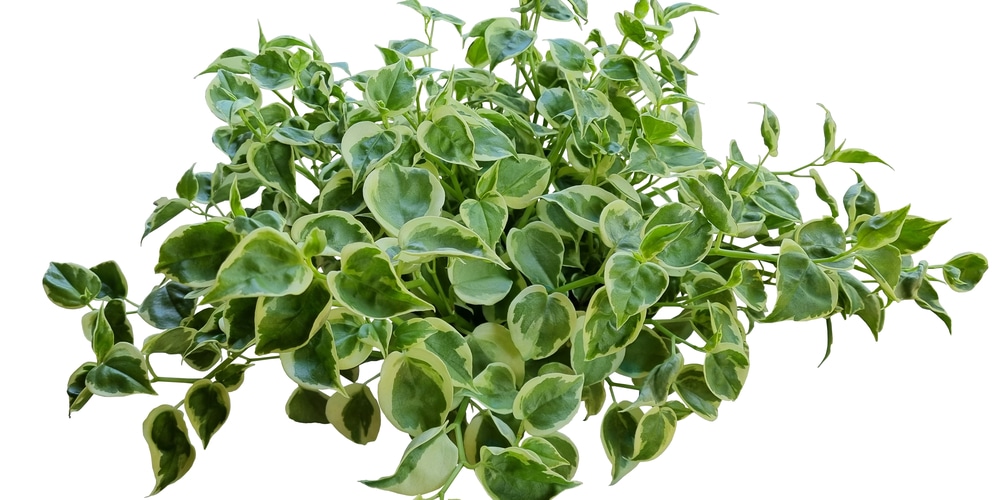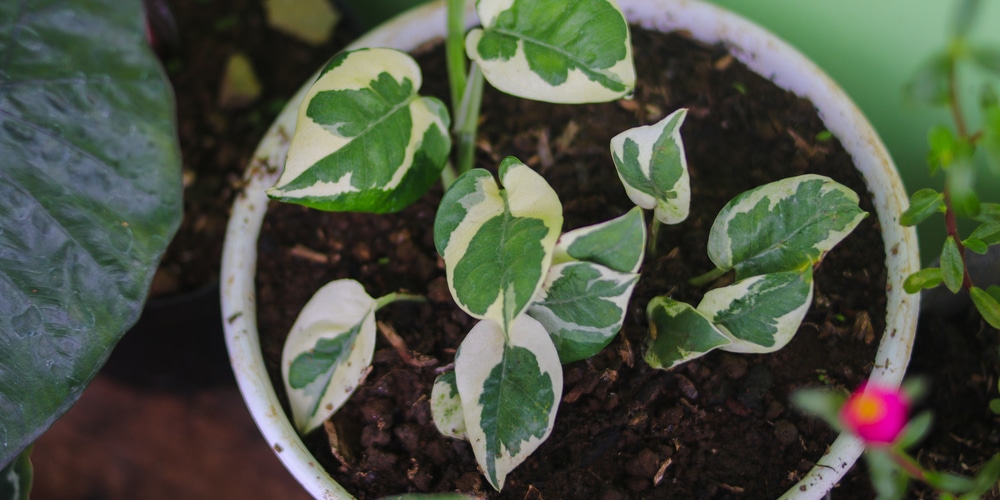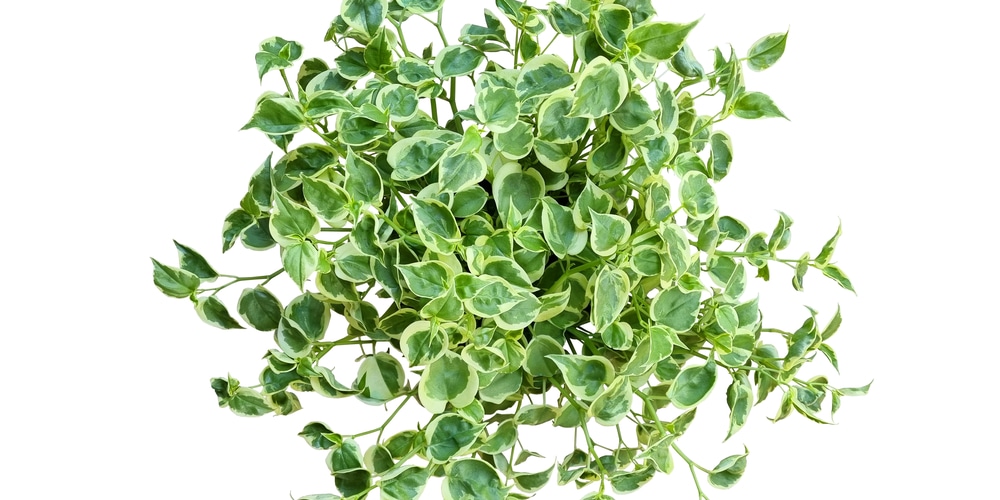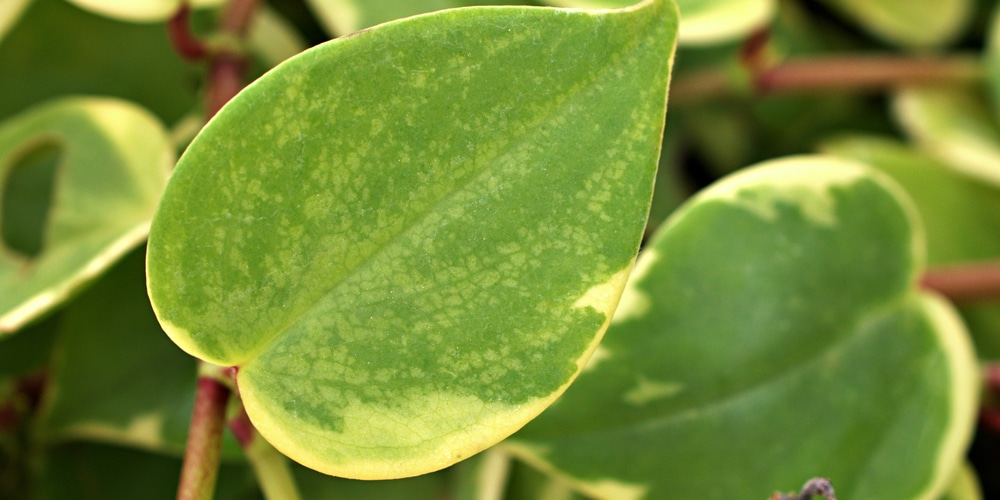The word “peperomia” means “like pepper.” And in fact, the foliage resembles a pepper plant. On top of that, the light green foliage displays creamy variegation on the outer edges of the leaves.
The Cupid variety is borderline succulent. So, it has thick leaves but is easier to maintain than regular succulents. It does well indoors and looks gorgeous in a hanging basket. But it is also a pleasant ground cover.

Cupid peperomia (Peperomia serpens) needs a hot, humid environment to thrive. This is why it usually grows during spring and summer in USDA zones with a milder climate. But in reality, it is a fast-grower that loves fertile, well-draining soils and bright indirect light.
- Botanical Name: Peperomia serpens, previously known as Peperomia scandens
- Common Names: Cupid Peperomia
- Plant Type: Perennial
- Flower Color: Greenish yellow–brown
- Size When Mature: 20-36 inches (height)
- Bloom Time: All year
- Light: Partial shade, bright indirect light
- USDA Hardiness Zones: 12a, 12b, 13a, 13b
- Soil PH Range: 6-7
- Soil Type: Well-draining
- Water Needs: Medium
- Native Area: Caribbean, tropical America
What You Need To Know About Peperomia Serpens
Cupid peperomia is a lovely, easy-to-grow houseplant, ideal for any beginner and plant parents. As its name implies, it has heart-shaped leaves that create a delightful pattern with an iridescent quality.
This foliage plant is soft and susceptible to thrips. So, while it is a beginner-friendly perennial, it still needs you to take a few precautions. Above all, it tends to become leggy and requires regular pruning.
Peperomia serpens is pet-friendly. Most importantly, it also is a vine plant. So, its leaves leisurely trail along, making this houseplant an aesthetic choice for your collection. What’s more, some stems are light pink, which makes them look even more elegant.
Most growers report the most difficult part of taking care of a Cupid peperomia is making it flower indoors. So, it is better to take cuttings to propagate this plant. Taking cuttings is also a faster method because water propagation works perfectly for this species.
How To Care For Cupid Peperomia
Here’s everything you need to know about growing and caring for a thriving Cupid peperomia.
Light
This cultivar variety is pretty flexible with light. Depending on your growth expectations, indirect bright light is the best option for Cupid peperomia. But if you want bright pops of color, a little morning light is highly recommendable.
Exposure to direct sunlight for long hours will result in burnt leaves. So, you can leave them sitting close to an east-facing window. But it is better to avoid south-facing windows and places with less than 50 foot-candles.
If you are growing this houseplant in a hanging basket, consider rotating it every two weeks for a fuller look.
Water and Soil Needs
Cupid peperomia has a small, shallow, and fragile root system. On average, it also has more succulent stems and leaves than flowers. So, that makes it the perfect candidate for root rot. To avoid root rot, which is when a plant is overwatered, you should be very careful with the amount of water you give to your Peperomia serpens.
Because of its thick stems, this cultivar is a little more resilient than other Peperomia varieties. But as a rule of thumb, only water this plant when the soil is almost dry. As an option, wait for the leaves to start softening and droop a little bit. And of course, when winter comes around, be sure to pull way back on the watering.
If you give your Cupid peperomia a well-draining soil, watering it once a week is more than enough.
About Repotting
When repotting your Peperomia, only go up 1-inch max in pot size. If possible, opt for a terracotta pot. And be aware that this species does not like repotting.
The best soil mixture is fertile soil with peat and sand. Add more sand before repotting the plant to increase drainage as needed. A point often overlooked when adding/creating the soil mix: remain within a neutral pH range (6-7).
Temperature Requirements
The best temperature range is between 60‐80 F. Equally important, protect this species against hot and cold drafts.
The standard household humidity level (40-60%) is fine. But Cupid peperomia is native to tropical areas (USDA zones 12-13). So it can withstand higher humidity levels.
You can think of this Peperomia as a drought-tolerant plant. But you can grow the Peperomia scandens in a terrarium as well. To keep it short, as long as you are comfortable, this plant will do great. On a more serious note, the foliage will die if you keep the temperature drop below 55F.
Fertilizer
Too much fertilizer can burn Cupid peperomia leaves as midday light would. If you exceed the dosage, the tips will get brown and crumble. From there, heavily dilute the organic, balanced fertilizer. Also, try waiting at least three weeks between each serving.
Using an all-purpose granular fertilizer (24-8-16) is also a good idea.
Common Diseases
Cupid peperomia can suffer from ring spot. But usually, most yellowing and leaf decay are attributable to:
- bacteria
- fungal growth
- overwatering
- viruses
Sometimes, pinpoint spots with no colored ring appear on the underside. They might be the sign of an early spider mite infestation. For clarity, these pests like to hide under the ridges on the leaves.
Cutting rot can also be a problem. This is why mixing a little bit of fungicide into the soil or media for starting plant cuttings is highly advisable.
Peperomia Scandens Propagation
Cupid peperomia is an easy plant to propagate because you can just cut the petiole and put it into water. To clarify, the petiole is the stem that connects the leaf to the main stem.
All you need to do is wait for the cutting to root. After that, transplant it into a well-draining soil mixture. Or some damp Sphagnum moss for better aeration.
The same procedure also works with undamaged leaves. In detail, you can cut a single leaf, and it will grow new roots both in water and in moist sand.
How To Prune Cupid Peperomia
If you want a bushy, healthy Cupid peperomia, you will have to trim the plant frequently. However, do not prune this ornamental plant after repotting it. Why? Because it will take a lot of time to adjust itself to the new soil conditions and environment.
Conclusion
Keep in mind that if you prune this plant in the colder months, it will take time to recover from each cut. Generally speaking, it is better to avoid dramatic cuts. Usually, this plant grows slowly in most indoor environments. So, it may not need pruning at all.
Related Article: Peperomia Hope


